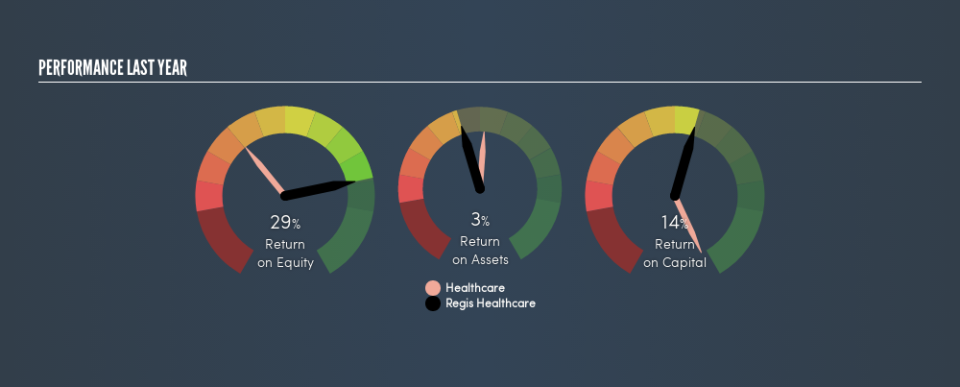Here’s What Regis Healthcare Limited’s (ASX:REG) ROCE Can Tell Us

Today we’ll evaluate Regis Healthcare Limited (ASX:REG) to determine whether it could have potential as an investment idea. To be precise, we’ll consider its Return On Capital Employed (ROCE), as that will inform our view of the quality of the business.
First up, we’ll look at what ROCE is and how we calculate it. Then we’ll compare its ROCE to similar companies. Finally, we’ll look at how its current liabilities affect its ROCE.
Understanding Return On Capital Employed (ROCE)
ROCE measures the amount of pre-tax profits a company can generate from the capital employed in its business. All else being equal, a better business will have a higher ROCE. Overall, it is a valuable metric that has its flaws. Author Edwin Whiting says to be careful when comparing the ROCE of different businesses, since ‘No two businesses are exactly alike.’
How Do You Calculate Return On Capital Employed?
The formula for calculating the return on capital employed is:
Return on Capital Employed = Earnings Before Interest and Tax (EBIT) ÷ (Total Assets – Current Liabilities)
Or for Regis Healthcare:
0.14 = AU$89m ÷ (AU$1.8b – AU$1.2b) (Based on the trailing twelve months to December 2018.)
Therefore, Regis Healthcare has an ROCE of 14%.
Check out our latest analysis for Regis Healthcare
Is Regis Healthcare’s ROCE Good?
When making comparisons between similar businesses, investors may find ROCE useful. Regis Healthcare’s ROCE appears to be substantially greater than the 9.4% average in the Healthcare industry. We would consider this a positive, as it suggests it is using capital more effectively than other similar companies. Regardless of where Regis Healthcare sits next to its industry, its ROCE in absolute terms appears satisfactory, and this company could be worth a closer look.
As we can see, Regis Healthcare currently has an ROCE of 14%, less than the 38% it reported 3 years ago. This makes us wonder if the business is facing new challenges.
When considering this metric, keep in mind that it is backwards looking, and not necessarily predictive. ROCE can be deceptive for cyclical businesses, as returns can look incredible in boom times, and terribly low in downturns. ROCE is only a point-in-time measure. What happens in the future is pretty important for investors, so we have prepared a free report on analyst forecasts for Regis Healthcare.
Do Regis Healthcare’s Current Liabilities Skew Its ROCE?
Short term (or current) liabilities, are things like supplier invoices, overdrafts, or tax bills that need to be paid within 12 months. Due to the way the ROCE equation works, having large bills due in the near term can make it look as though a company has less capital employed, and thus a higher ROCE than usual. To check the impact of this, we calculate if a company has high current liabilities relative to its total assets.
Regis Healthcare has total assets of AU$1.8b and current liabilities of AU$1.2b. As a result, its current liabilities are equal to approximately 67% of its total assets. Regis Healthcare has a relatively high level of current liabilities, boosting its ROCE meaningfully.
The Bottom Line On Regis Healthcare’s ROCE
This ROCE is pretty good, but remember that it would look less impressive with fewer current liabilities. Of course, you might find a fantastic investment by looking at a few good candidates. So take a peek at this free list of companies with modest (or no) debt, trading on a P/E below 20.
For those who like to find winning investments this free list of growing companies with recent insider purchasing, could be just the ticket.
We aim to bring you long-term focused research analysis driven by fundamental data. Note that our analysis may not factor in the latest price-sensitive company announcements or qualitative material.
If you spot an error that warrants correction, please contact the editor at editorial-team@simplywallst.com. This article by Simply Wall St is general in nature. It does not constitute a recommendation to buy or sell any stock, and does not take account of your objectives, or your financial situation. Simply Wall St has no position in the stocks mentioned. Thank you for reading.

 Yahoo Finance
Yahoo Finance 
